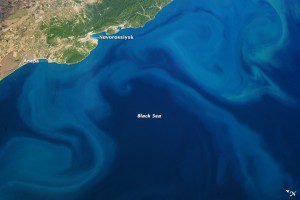
Phytoplankton are visible as blue to turquoise streams and swirls, carried by currents along the coastline and further out toward the middle of the sea. The urban areas of Anapa and Novorossiysk”the largest Russian seaport on the Black Sea”are visible along the northern shoreline as gray-white regions nestled between the sea and uplands dotted with limestone quarries.
An astronaut photograph, taken from the International Space Station, highlights a recent gigantic plankton bloom in the Black Sea's eastern half. The Black Sea, a large inland water body that connects eastern Europe and Asia Minor, frequently hosts widespread blooms of phytoplankton during the spring and summer seasons.
Phytoplankton occupy the base of most aquatic food chains and therefore serve as the primary producers in these ecosystems, despite being microscopic in size. The term phytoplankton includes several organisms”cyanobacteria, diatoms, dinoflagellates, algae and coccolithophores”that feed larger creatures such as fish and shrimp.
The Black Sea receives contributions of freshwater from several river systems, including the Danube, Dnieper, Dniester and Don, but it's also connected to the saline Mediterranean and Marmara Seas. These same river systems transport nutrient-filled urban and agricultural runoff to the Black Sea; the nutrients are consumed by phytoplankton and lead to blooms.
Image courtesy of NASA.

